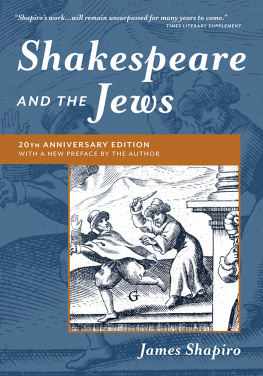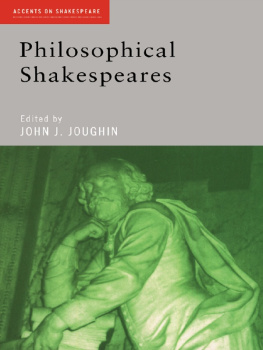Routledge Library Editions
SHAKESPEARE'S HISTORIES

SHAKESPEARE
Routledge Library Editions Shakespeare
HISTORY & POLITICS
In 6 Volumes
I | Shakespeare's Histories | Campbell |
II | England in Shakespeare's Day | Harrison |
III | Shakespeare Reproduced | Howard & O'Connor |
IV | Shakespeare and the Lawyers | Phillips |
V | The English History Play in the Age of Shakespeare | Ribner |
VI | Power on Display | Tennenhouse |
SHAKESPEARE'S
HISTORIES
Mirrors of Elizabethan Policy
LILY B CAMPBELL

First published in 1947
Reprinted in 2005 by
Routledge
2 Park Square, Milton Park, Abingdon, Oxon, OX14 4RN
Transferred to Digital Printing 2008
Routledge is an imprint of the Taylor & Francis Group
All rights reserved. No part of this book may be reprinted or reproduced or utilized in any form or by any electronic, mechanical, or other means, now known or hereafter invented, including photocopying and recording, or in any information storage or retrieval system, without permission in writing from the publishers.
The publishers have made every effort to contact authors/copyright holders of the works reprinted in Routledge Library Editions Shakespeare. This has not been possible in every case, however, and we would welcome correspondence from those individuals/companies we have been unable to trace.
These reprints are taken from original copies of each book. In many cases the condition of these originals is not perfect. The publisher has gone to great lengths to ensure the quality of these reprints, but wishes to point out that certain characteristics of the original copies will, of necessity, be apparent in reprints thereof.
British Library Cataloguing in Publication Data
A CIP catalogue record for this book
is available from the British Library
Shakespeare's Histories
ISBN 0415353106
ISBN 0415330866 (set)
Miniset: History & Politics
Series: Routledge Library Editions Shakespeare
SHAKESPEARE'S
Histories
MIRRORS OF ELIZABETHAN
POLICY
BY
Lily B. Campbell
METHUEN & CO LTD
11 NEW FETTER LANE EC4
First published 1947 in the U.S.A.
Third edition 1963
First published in Great Britain 1964
Reprinted 1968
S.B.N. 416 23010 5
1.2
First published as a University Paperback 1964
Reprinted 1968
S.B.N. 416 68430 0
1.2
Printed and bound in Great Britain by
Butler & Tanner Ltd, Frome and London
This book is available both as a hardbound
and as a paperback edition
The paperback edition is sold subject to the condition that it shall not, by way of trade or otherwise, be lent, re-sold, hired out, or otherwise circulated without the publisher's prior consent in any form of binding or cover other than that in which it is published and without a similar condition including this condition being imposed on the subsequent purchaser.
CONTENTS
PREFACE
THE EDITORS of the First Folio collection of Shakespeare's plays classified them as comedies, histories, and tragedies, thus taking cognizance of history as a dramatic genre. It was a genre that grew in popularity during the last half of the sixteenth century in England, and it was as different from tragedy and comedy as they were from each other. All three of these generic names were applied to nondramatic as well as dramatic writing, and it is my belief that just as dramatic tragedy has come to be better understood since it has been considered in relation to the broad concepts of tragedy manifest not only in dramatic but in non-dramatic works as well, so will history be better understood when we stop talking about it in terms of the ancient classical dramatic genres and consider it in relation to general principles of historical writing exemplified alike in dramatic and non-dramatic literature.
This book is directed, therefore, to discovering the principles and methods of historiography which were current in sixteenth-century England and to demonstrating the way in which Shakespeare applied them when he wrote his histories. Shakespeare, of course, used history as story material in many of his other plays in his Roman plays, for instancebut I am not here concerned with story material as such, whether it is derived from history or elsewhere; I am concerned solely with the kind of play listed as a history by his editors.
To cover in a single book the development of historiography in the English Renaissance and the exemplification of this theory in Shakespeare's practice has necessitated that I discard most of my notes on the background material and a goodly portion of my notes on the Shakespearean plays. I have shed these accumulations of many years with reluctance, but because of the great bulk of the material I could present just so much as might be required to make clear and to illustrate the determining ideas in sixteenth-century historical writing and Shakespeare's methods of using them.
The limits of a readable book have also been primarily responsible for my including only studies of King John, Richard II, Henry IV, Henry V, and Richard III. This group of plays seems to me to offer ample illustration of Shakespeare's methods. However, my decision to omit Henry VIII has been influenced by the fact that it does not occupy an assured place in the Shakespeare canon. And I have omitted Henry VI because I have found it quite impossible to discuss without reviewing and reconsidering the evidence concerning the sequence and the dates of the three parts. The problem is complicated by the re-using of material which had already been altered in the Mirror for Magistrates to fit the times of Edward VI. I hope to publish separately a study of Henry VI, but it is too long and too much involved in the consideration of problems other than that of dramatic genre to be included here.
It is apparent that a broader survey of history as a dramatic genre is needed. From Gorboduc to Chapman there are plays unexplored from this point of view. But however enticing the opportunities, one life and one book are not enough to make much of them. I can only hope that other students of the drama will add to these beginnings by investigating plays directed to similar ends.
I have been at work upon the materials here gathered together for many years, and the research funds of the University of California provided help in securing photostats and transcribing documents before the war took away the possibilities of such services. When my work seemed bound to be terminated by the round-the-calendar teaching schedule of the war, the Huntington Library made me an affiliate member of its research staff and secured to me a few weeks in the year for completing this study. To both institutions I am grateful, as I am also grateful to my several colleagues in both institutions who have from time to time given me gleanings from their reading or have read critically bits and pieces of my manuscript. To Professors Louis B. Wright and Godfrey Davies, however, I owe special thanks, for they have read the whole.



















